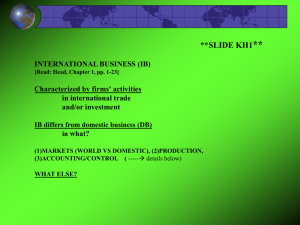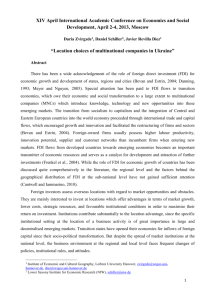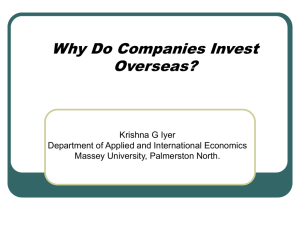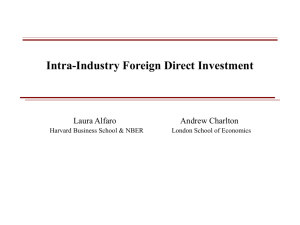Entry mode Advantage Disadvantage OWNERSHIP INVOLVED
advertisement
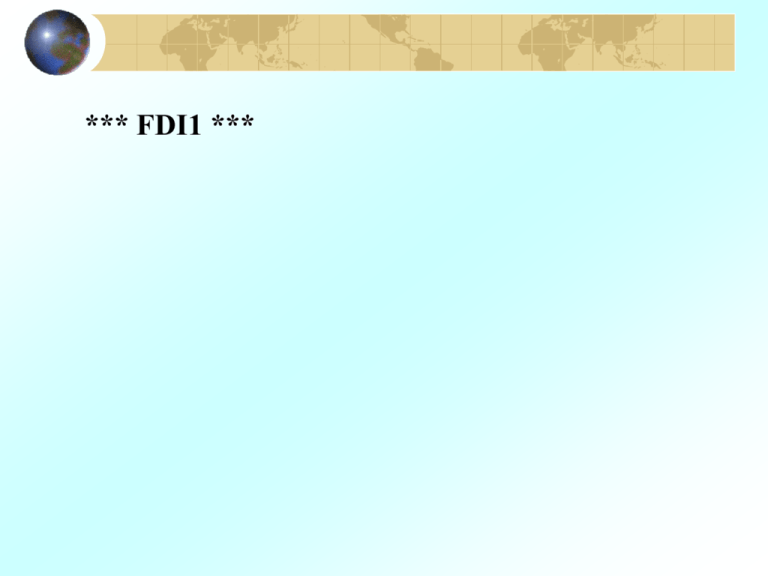
*** FDI1 *** Various entry modes into foreign markets: advantages and disadvantages Entry mode Advantage Disadvantage NO OWNERSHIP INVOLVED Exporting from home production scale economy; trade secrets kept Turnkey contracts little financial risk; possible where FDI prohibited [e.g., petrochemical plants] Licensing low cost, low risks Franchising low cost, risks trade barriers; transportation cost; local marketing: by whom? may create efficient competitors; no long-term presence lack of control over your own technology [licensing and other types of contracts used in every FDI project] [e.g., retail sector] lack of control over quality; global strategic coordination difficult Entry mode Advantage Disadvantage OWNERSHIP INVOLVED Joint ventures access to local lack of control partner's knowhow over technology; in marketing, slow decision making personnel management, local government; shared risks and cost Fully owned subsidiary protection of technology; fast decisions high risks and high cost BUSINESS DECISION: which mode of foreign entry?; what share of ownership, if ownership involved? SOME THEORIES ON FDI Efficiency considerations lead to various forms of FDI organizations HORIZONTAL FDI: your FDI in the host country is in the same industry as in home country (e.g. following customers) BACKWARD VERTICAL FDI: provides inputs into your home operation (e.g. resource FDI) FORWARD VERTICAL FDI: receives from you the inputs produced in home country (e.g. sales/distribution channel FDI) Vertical and horizontal integration often increases production efficiency due to scale economies. Many theories try to explain why firms prefer FDI to pure "purchasing/selling arrangements“ [e.g. presence of trust in firms’ own FDI] IMPORTANT FACTORS WHICH AFFECT FDI DECISIONS: - TRANSPORTATION COSTS ($3-12 per auto tire) - MARKET SIZE (e.g. economies of scale) - MARKET IMPERFECTIONS (e.g. tariffs, quotas, .....) - FEAR OF TECHNOLOGY/KNOW-HOW SPILLOVER (problems with technical licensing without ownership; but how much ownership?) - FOLLOW-THE-LEADER AND/OR CUSTOMER, ME-TOO BEHAVIOUR (e.g. firms in Toyota/Honda/Nissan capital keiretsu firms) - PLC STAGES ... AT SOME STAGE OF A PLC, YOU HAVE TO EXPLOIT FOREIGN MARKETS AND/OR SOURCE FROM FOREIGN LOW-COST PRODUCERS - CORPORATE POLICY (to become multinational by policy?) VARIOUS FORMS OF FOREIGN EXPANSIONS (ref. Head (111-129)) below Foreign Country Home Country Home Centralization (Exporting) Replication Foreign Centralization (Importing) Home Centralization: –Boeing commercial aircraft assembly in U.S. (mainly Seattle) –Airbus commercial aircraft assembly in EU (mainly Toulouse) Foreign Centralization: –Mattel’s Barbie dolls (Dongguan, China) –Panasonic’s TVs (Malaysia) Nestle (replicator) had 254,000 Employees in 508 Factories in 85 Countries in 2002. Area Sales Factories Employees Americas 40% 32% 41% Europe (Switz.) 40% (1.6%) 41% (1.8%) 34% (2.6%) Asia, Africa & Oceania 20% 27% 25% The benefits of Home Centralization: Strong Low economies of scale, that is plant-level fixed costs are high trade costs to export to foreign country Large home market Home country has comparative advantage in production costs The benefits of Foreign Centralization: Strong Low economies of scale, that is plant-level fixed costs are high trade costs to import from foreign country Large foreign market Foreign country has comparative advantage in production costs The benefits of Replication Form: Absence of economies of scale, that is plant-level fixed costs should be low Both markets are large High trade costs impede exports & imports Unimportant comparative advantages, that is costs of production similar across countries. The following graphs show the tradeoffs between 'Home Centralization" and "Replication" strategies in terms of the foreign market size and distance WH = home factory unit cost of production WF = foreign factory unit cost of production K = capital cost of building a new factory T = transportation and trade costs MF = foreign market size (e.g. # of consumers) Forms of multinational firms with multiple products Upstream (U) creates inputs Downstream (D) uses U inputs to create outputs Example: ExxonMobil Upstream: exploration and “production” in 40 countries Downstream: refining and “marketing” Owns 46 refineries, located in 26 countries Operates 42,000 retail sites in 118 countries The maps below show ExxonMobil's Upstream and Downstream operations. Various forms of multinational operations for producing 2 vertically related products (various combinations of U and D) E.g. U: auto parts D: passenger car The firm wants to sell 2 related models of cars Reasons for "vertical specialization": Strong economies of scale, that is plant-level fixed costs are high Low trade costs to export U to foreign country Low trade costs to import D from foreign country Home country has comparative advantage in production costs for U Foreign country has comparative advantage in production costs for D "Branching form" examples: Coca Cola’s concentrate (U) and bottling (D) Honda's engines (U) and car assembly (D) Reasons for "branching form": Low trade costs on U, high on D Low scale economies on D, high on U Home comp. adv. in U, weak comp. advs. in D "Multi-sourcing form" examples: Refinery in one country, sourcing crude oil from multiple drilling sites (in different countries); Nike’s strategy of shoe manufacturing Reasons for "multi-sourcing form": Low trade costs (for U & D) Diseconomies of scale for U Uncertain comp. adv. for U. More figures are found on Head, p.125. Currently we are experiencing: (1)Falling trade costs - more efficient transportation (containers, use of air transport) - lower tariffs, WTO oversight of disguised protection - technology-powered improvements in long distance communication (2)This may be leading to increased "economies of scale" The implications of (1) and (2) for multinational firms: Optimal configuration of your FDI network requires continuingly changing efficiency calculations; in particular “Less Replication”, and more “Vertical Specialization” But we also need to pay attention to industry-specific conditions: Example: Compare various companies' foreign expansion strategies: Nestle, Boeing, Mattel Their strategies are not likely to converge. (They will continue to pursue divergent strategies)






